A stone fence is so often used in landscape design that it is difficult to surprise them. But implementation does not always deserve the word "design". Therefore, in order to create a beautiful fence on your site, you should familiarize yourself with this article, which contains the main recommendations from landscape design specialists.
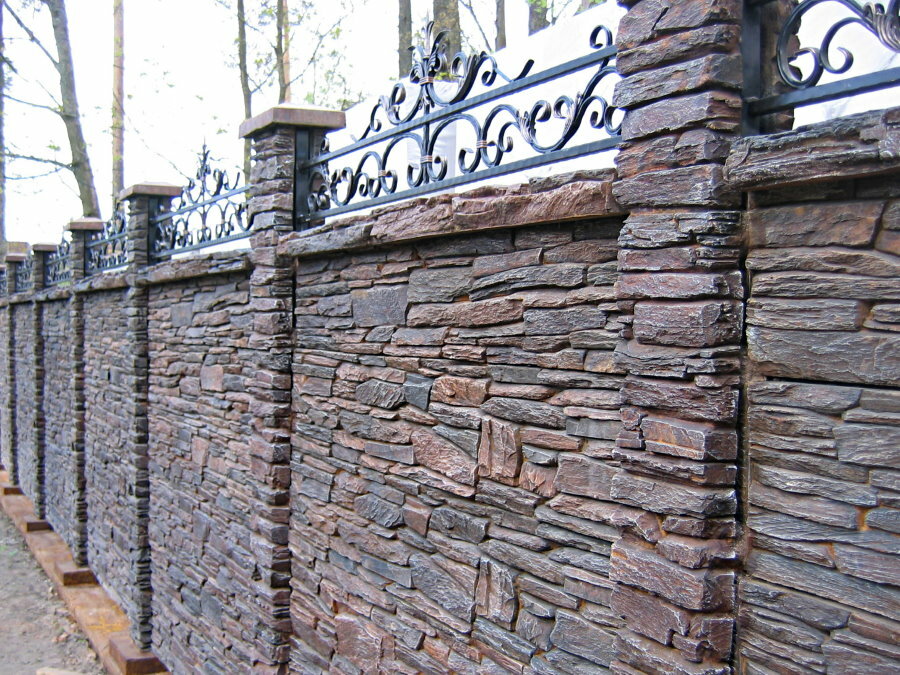
At all times, the use of natural stone for the construction of a fence is a sign of the wealth of the owners of the site.
Pros and cons of stone fencing in landscaping
Content
- Pros and cons of stone fencing in landscaping
- The foundation of a stone fence - how to make beautiful
- Stage 1. Trench preparation
- Stage 2. Pouring the foundation
- Stage 3. Fence masonry
- The main types of stone and its features
- Rubble stone
- Dolomite
- Boulders and cobblestones
- Gravel
- Limestone (shell rock)
- Sandstone
- Fake diamond
- Stone fence decor - types of decorative finishes
- Video: Bricklaying a fence made of rubble stone
- Photos of beautiful examples of finished stone fences
A stone fence, regardless of whether it encloses the entire territory of the site from the external space or is used for internal zoning of the territory, has its own special characteristics.
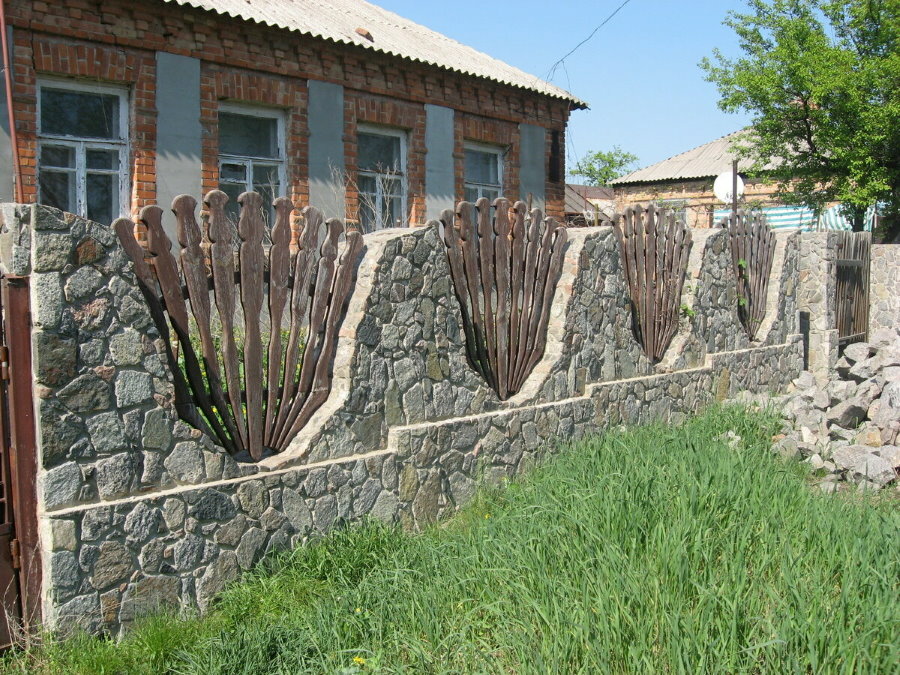
Stone is an excellent material for the construction of durable and strong fences
Of the positive, it is worth noting:
- Due to high strength indicators, it is possible to achieve resistance not only to mechanical, but also to negative natural influences.
- In some cases, you can build such a fence on a budget using available material, for example, cobblestone.
- Masonry can be combined with other building materials for a high level of aesthetics.
- With a high-quality performance, an attractive appearance and an elegant finish are achieved.
- Fits perfectly into almost all landscape styles.
- Its durability, with proper laying, is very high. Especially if he is provided with proper care.
- It is fireproof.
- Completely environmentally friendly.
But, despite such numerous advantages, it also has pronounced characteristic disadvantages:
- High financial costs. Especially if you buy a special stone that has certain external effects.
- It is important to make a high-quality foundation for the fence in order to ensure its durability and strength. Otherwise, the design loses a number of its positive qualities.
Considering all the pros and cons, it is important to understand what can be done, both a fence made of natural stone and artificial material.
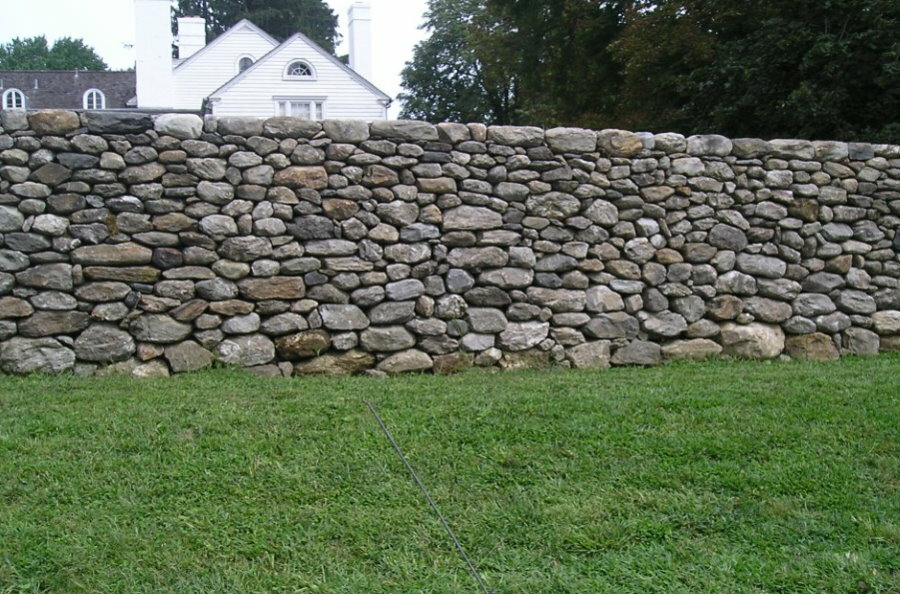
A stone fence can be in the form of a solid wall or a stone can only be used for the basement and fence posts
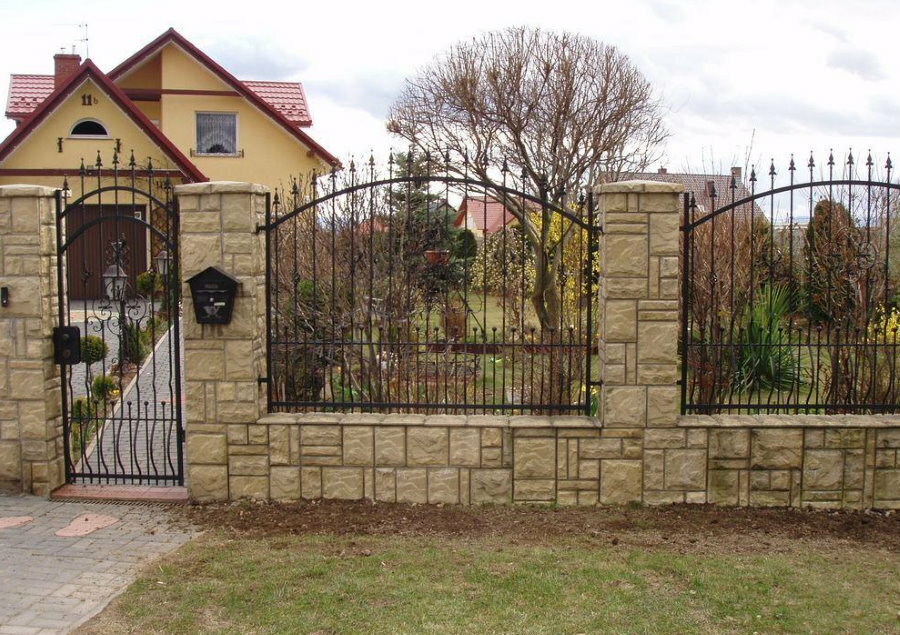
In any case, stone elements are perfectly combined with metal or wood inserts.
The foundation of a stone fence - how to make beautiful
Before making a stone fence, it is necessary not only to choose the material, but also to correctly calculate all the mechanical loads that it will bear. It is important to do this, since a mistake at this stage can then lead to the subsidence of individual sections or the collapse of the entire structure.
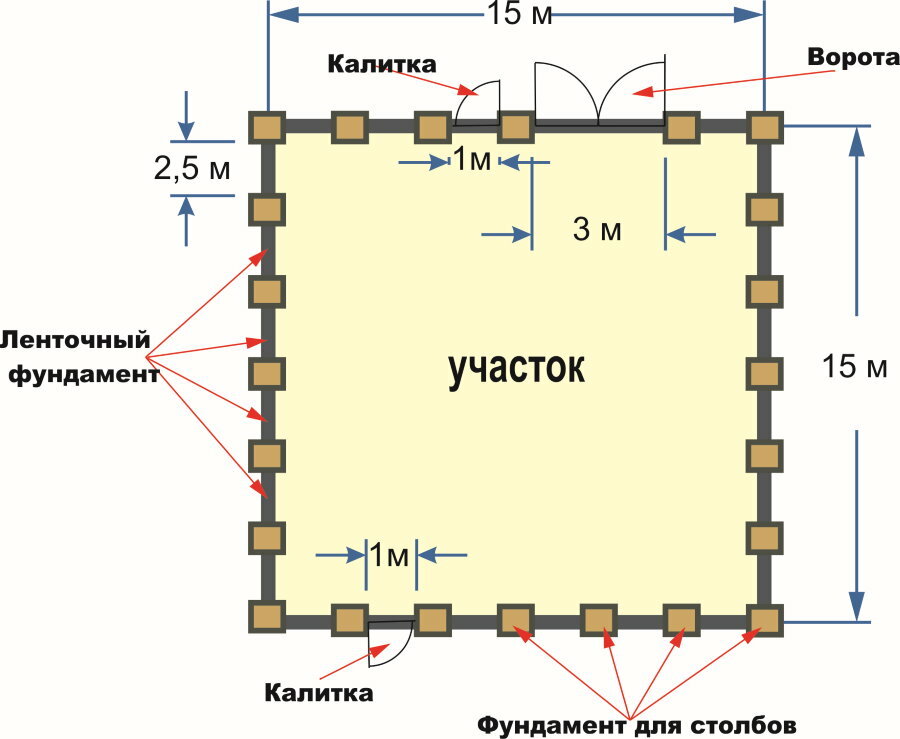
Foundation plan for a stone fence
Therefore, the first thing to do is to build a foundation for the fence. To do this, you must follow the following technological sequences:
Stage 1. Trench preparation
- Clear the area, removing not only all the debris and plants.
- Level the ground.
- With the help of special paint, carry out the markup, transferring the drawing to the area. Here you can also use rods and a sufficiently strong rope that will be pulled between the pegs.
- Drive in the marking racks along the perimeter of the site, or rather along the individual planes of the fence.
- Pull the string between the marking posts.
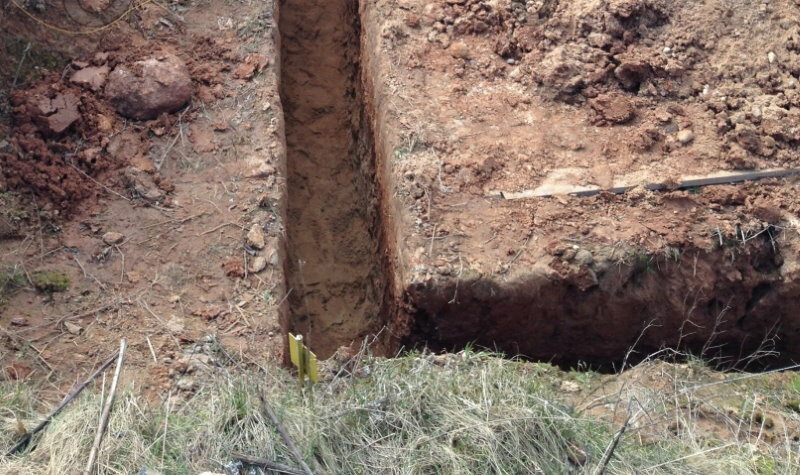
Further, according to the marking, you need to dig a trench
Foundation dimensions:
- The width of the foundation should be 15 cm wider than that of the rest of the fence.
- In height, the plinth should protrude above the ground. But the exact parameter can be chosen at your own discretion. Experienced builders recommend making it at least 10 cm. Whereas the designers insist that this figure should vary in the range from 10 to 15 centimeters, as this emphasizes the solidity of the structure and its stability.
- The depth of the trench for the foundation is about 70 cm.
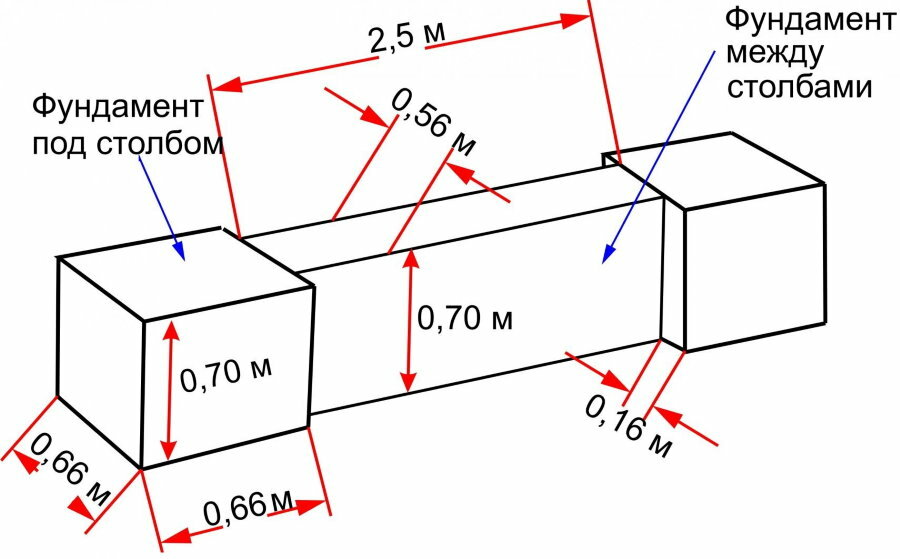
Drawing of a monolithic foundation for a stone fence
Stage 2. Pouring the foundation
- Sand 5 cm thick is poured to the bottom. Carry out its ramming.
- Then the formwork is exposed.
- Then the reinforcing frame is laid in 2 layers. After that, concrete is poured.
- In this case, it is very important to remove the formwork no earlier than 14-15 days after pouring. And then let it dry for 30-40 days. Only in this case it will be possible to give a load to it in the form of the entire main structure of the fence. Otherwise, it may crack.
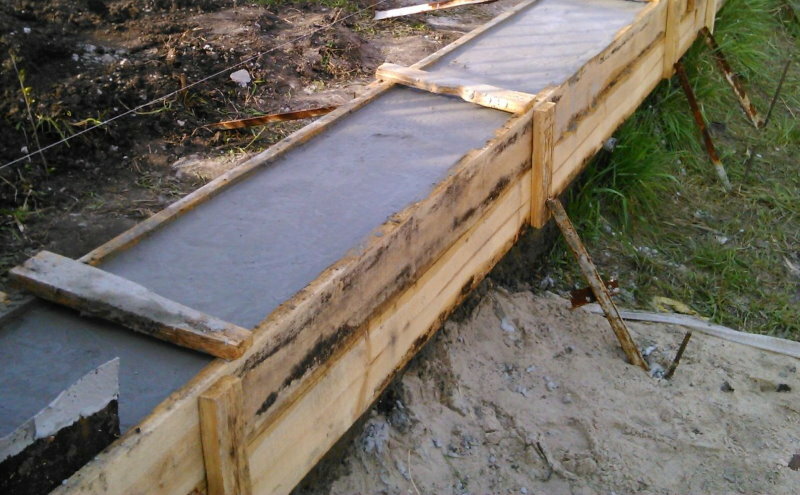
After pouring, the foundation is left to dry and build strength
Stage 3. Fence masonry
After the foundation has dried, it is necessary to build pillars that will serve as the main supports along with the foundation. The main sections of the stone fence will be laid between these pillars.
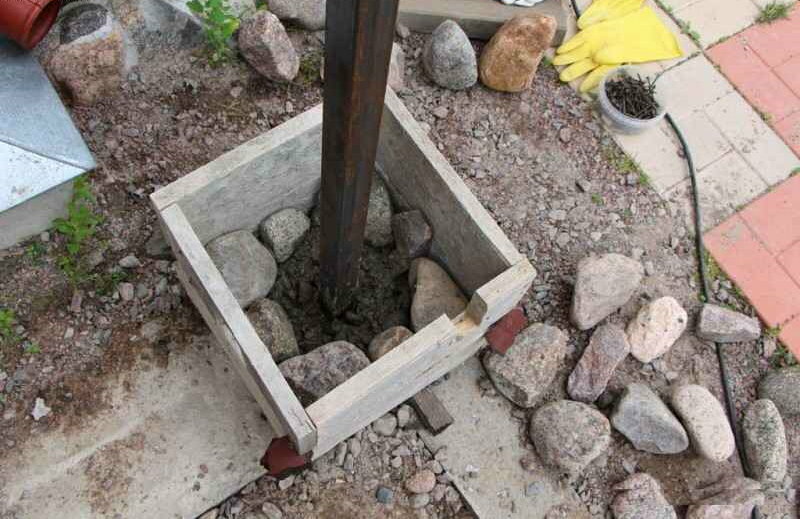
When using small stone, it is recommended to reinforce the support posts with metal elements.
The pillars are also built taking into account the fact that the formwork must be erected. It is important to lay the stones in such a way that they fit snugly not only to themselves, but also to the walls of the formwork. Gaps must be eliminated as much as possible in this case.
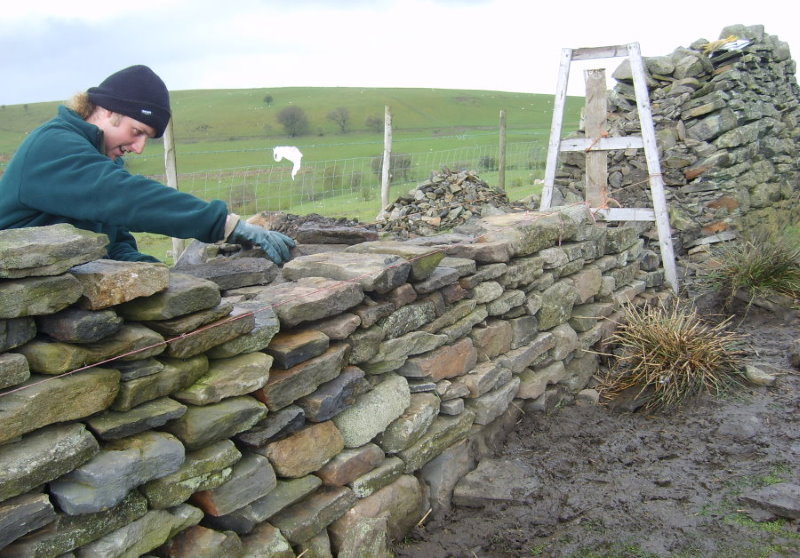
The fence masonry technology depends on the format of the stone used
Remember that the stones are laid on a thick cement mixture, which helps them to connect and form a solid structure.
In no case do not install the entire structure at once, but do it in layers and wait at least 1 day between certain layers of pillars. Only in this case will the structure have time to dry completely and acquire the strength it needs.
In terms of visual appeal, one type of stone can be used for pillars and foundations. And for the spans between the pillars, a different type is chosen. Moreover, most often he uses not only a different texture of the stone for these two main parts of the fence, but also different color solutions. This option can be realized by erecting a fence made of wild stone and artificial. But, naturally, everything will be much simpler for synthetic materials. Especially from the point of view of the selection of the desired color range.

A low fence can be laid out using the dry masonry method, when carefully selected stones are under their own weight. Such a fence has more decorative than practical function.
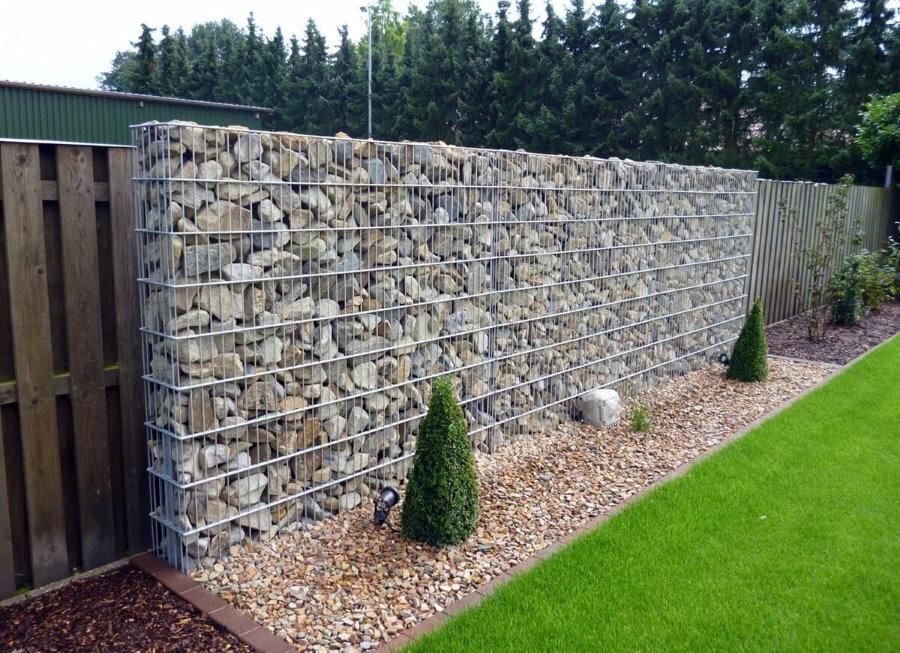
The varieties of fences made of stone also include gabions, in which the bonding of natural material occurs with the help of a metal mesh.
The main types of stone and its features
You can use a stone for the construction of main fences and small fences inside the site. At the same time, it is important to choose it in such a way that it is in harmony with the landscape gardening itself on the territory and the erected structure. Only in this case the design will look as attractive as possible.
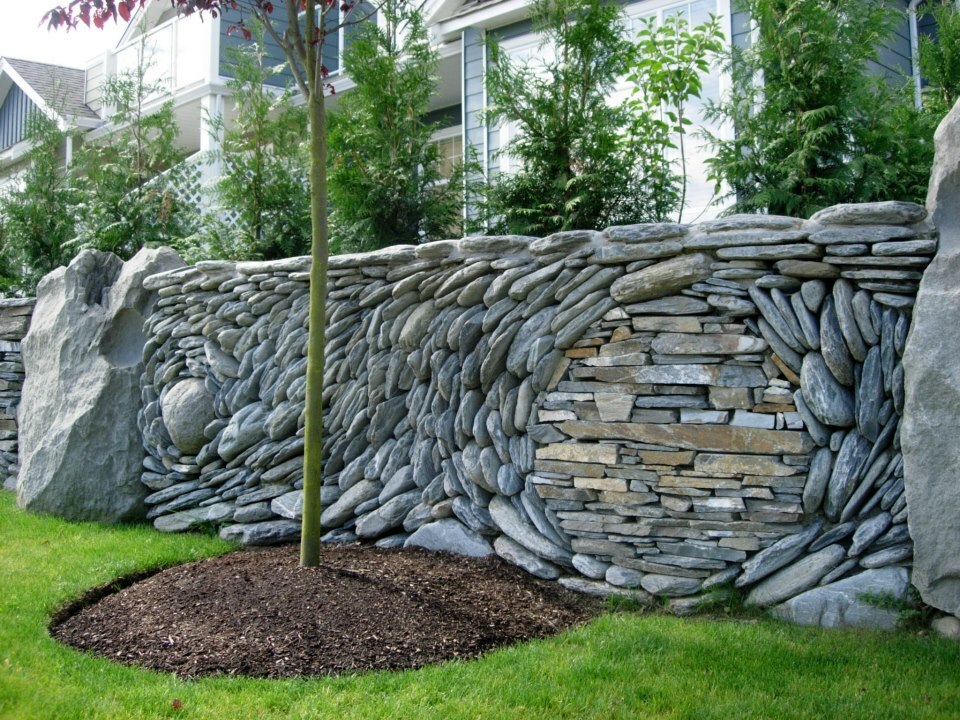
A stone fence, in addition to its main security function, can and should be beautiful
Rubble stone
The rubble stone for the fence can be made of limestone, sandstone or dolomite. Moreover, individual pieces most often have an irregular shape with their impressive length.
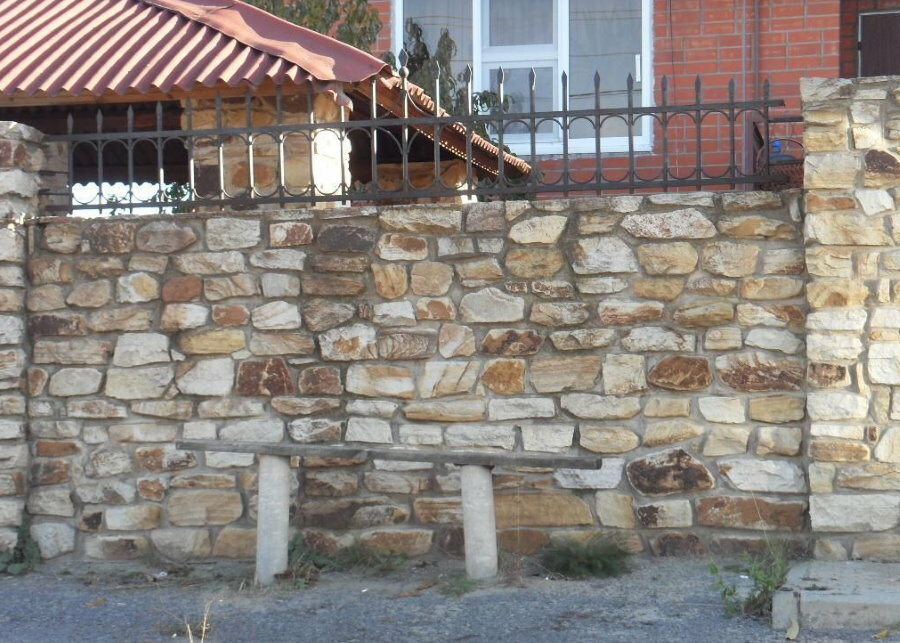
Deaf fence made of rubble stone with metal decor
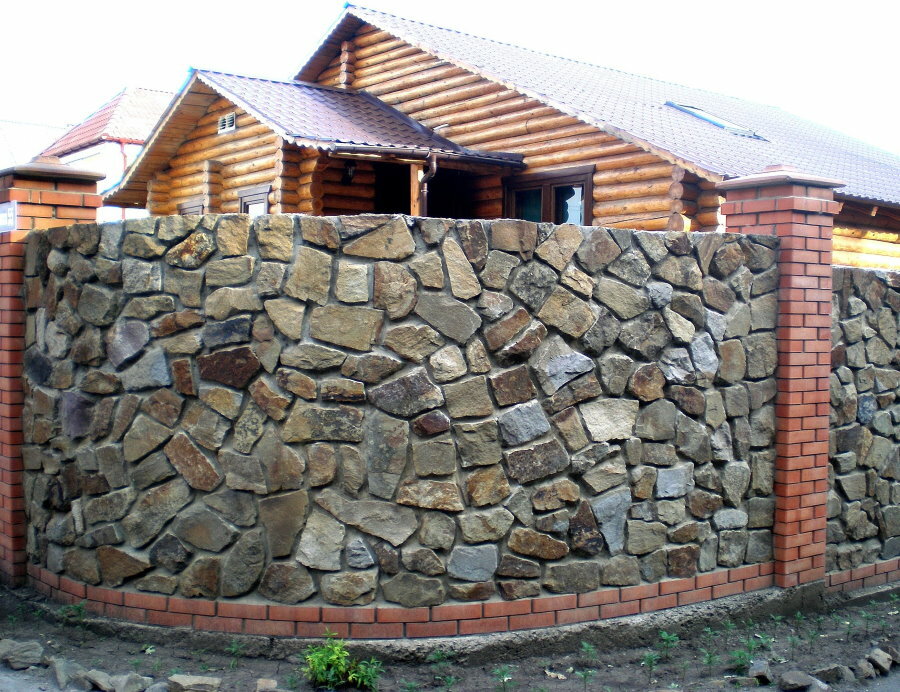
Capital fence made of a combination of rubble stone and facing brick
Dolomite
Dolomite has a flat shape, which allows it to be stacked as conveniently as possible. In terms of its overall dimensions, including thickness, it can be very diverse. Therefore, it can be used to make fences with different end effects.
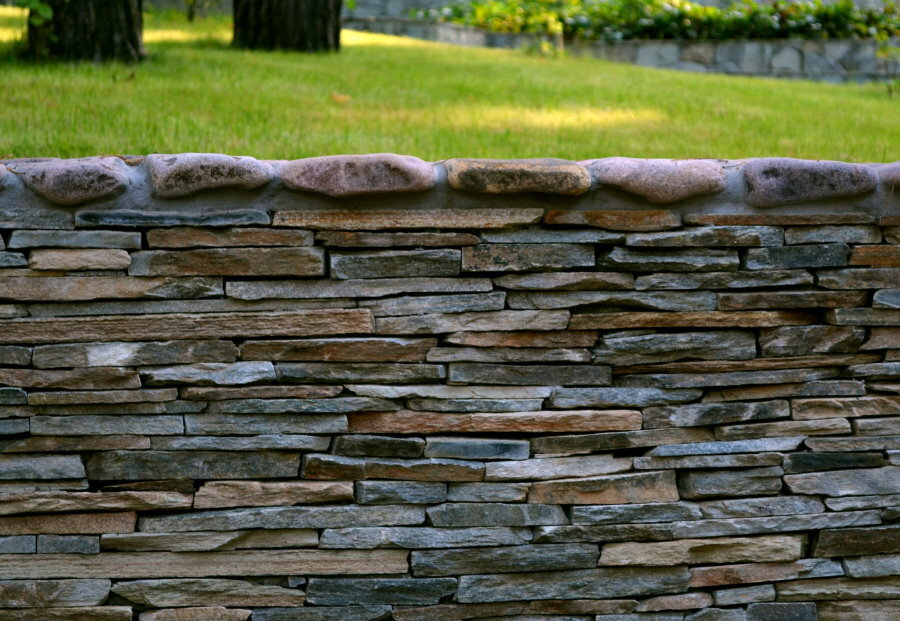
Due to the small thickness of the stone, a significant amount of cement mortar will be required for the construction of such a fence.
Such a breed is mined in mountain quarries. It has a fairly high strength and an attractive appearance. Therefore, creating such a fence, you can achieve high aesthetics, due to which private cottages and houses acquire additional positive effects in terms of creating landscape style.
Boulders and cobblestones
This option is the most affordable in terms of the financial resources spent. But, it has a low aesthetic value, since a boulder stone or cobblestone has an unattractive appearance and a specific gray tint. But, with all this, it is distinguished by high strength indicators, therefore such a structure will stand for a long time, without changing its main performance indicators.
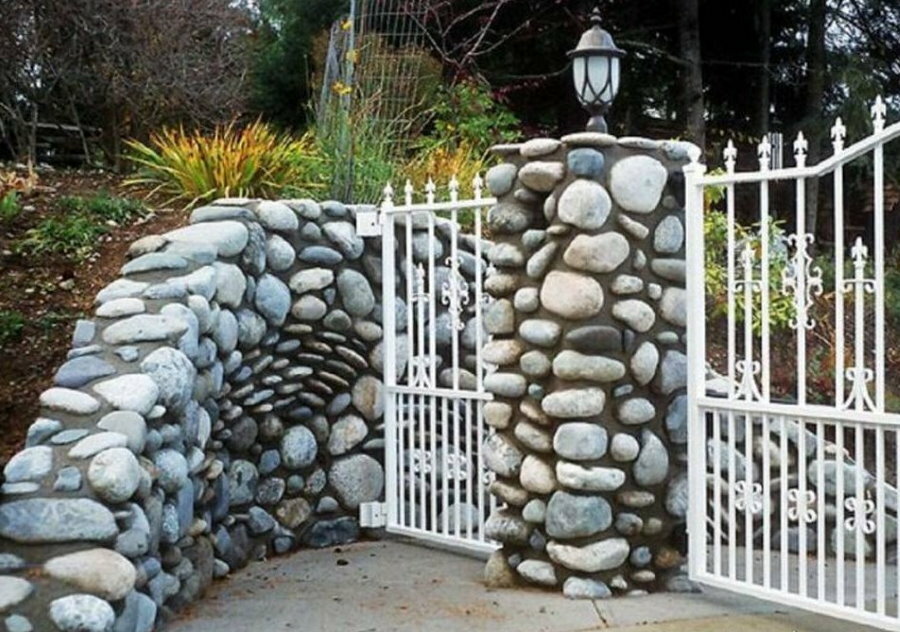
From boulders of various sizes, you can make a rather attractive fence that goes well with metal wickets and gates
Therefore, if there is a need to save money, but at the same time get the most attractive appearance, the designers recommend perform a mosaic structure that combines not only gray cobblestone, but also a reddish brown decorative a rock.
Gravel
Gravel is a stone of small overall dimensions. But, with all this, it also has differences:
There is too fine gravel that is used for fences that are dominated by a steel frame.
Medium to coarse gravel looks great when paired with concrete or brick.
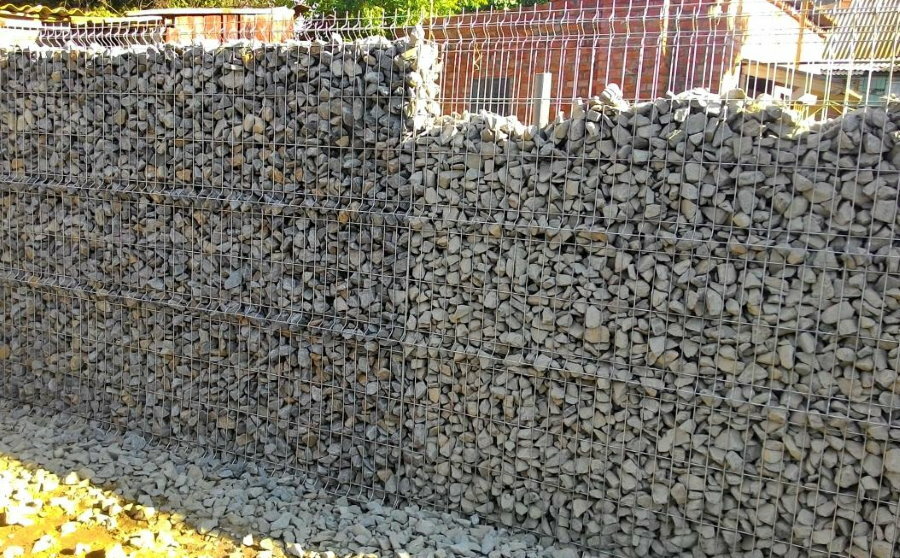
For the construction of a gravel fence, a metal frame and a mesh with small cells are used.
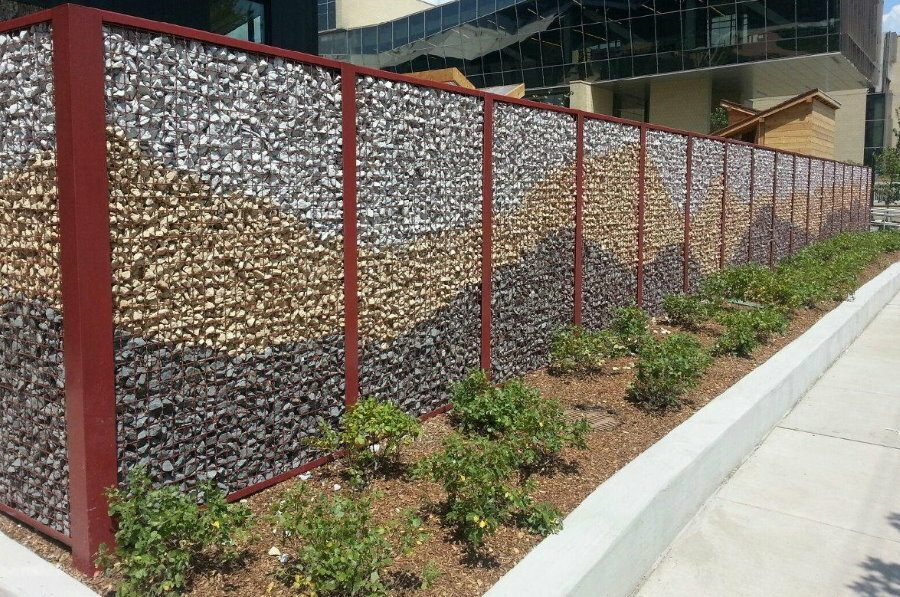
By combining gravel of different colors, you can create different design effects.
Limestone (shell rock)
Limestone by its nature can be:
- in the form of marble fractions;
- bryozoan;
- in the form of a shell rock.
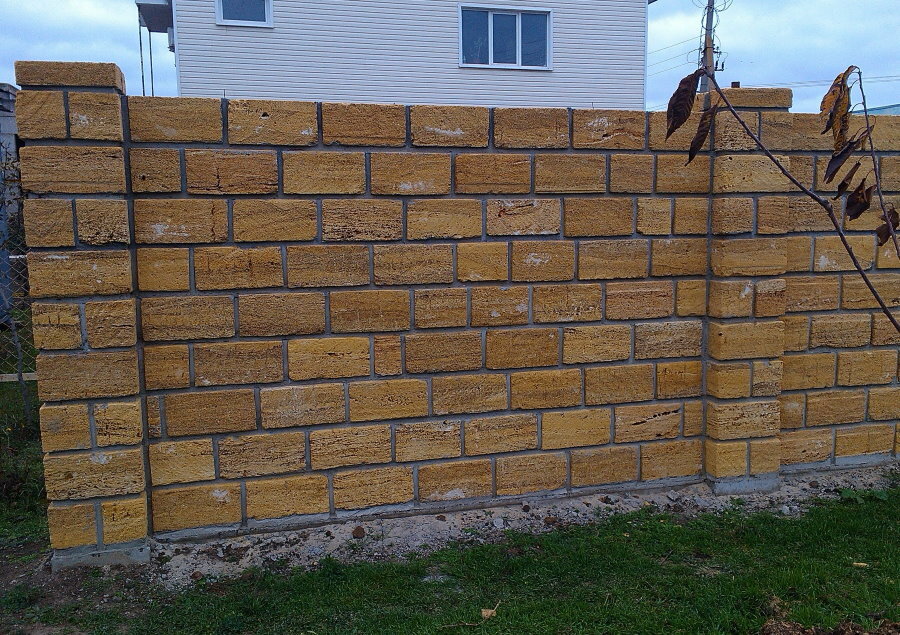
Shell rock is a natural stone that comes to the consumer in the form of large-format blocks
The finer the grain structure, the denser this material will be. In addition, some natural limestones are resistant to negative temperatures.
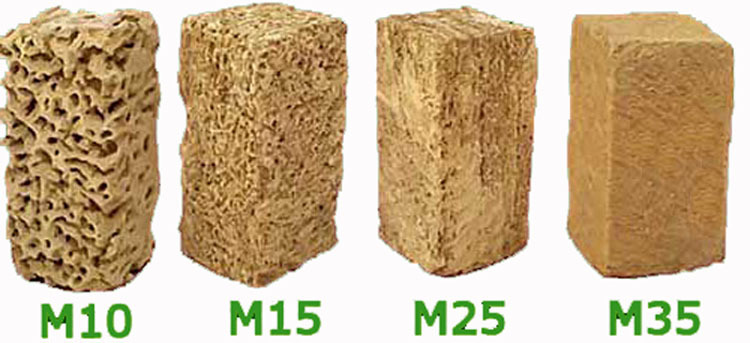
Shell rock is divided into grades depending on the density of the material
But there are other limestone rocks that are characterized by increased porosity. These are oolites and pisolites. Due to the fact that they are quite soft, they are easy to process as needed for laying a fence. But, in this case, they will quickly collapse without special impregnation. Therefore, they are covered with water repellents.
Sandstone
If you prefer a sandstone stone, then you can achieve the following effects of the finished fence:
- high strength indicator;
- high rates of frost resistance;
- also, such a fence will not be negatively affected by water.
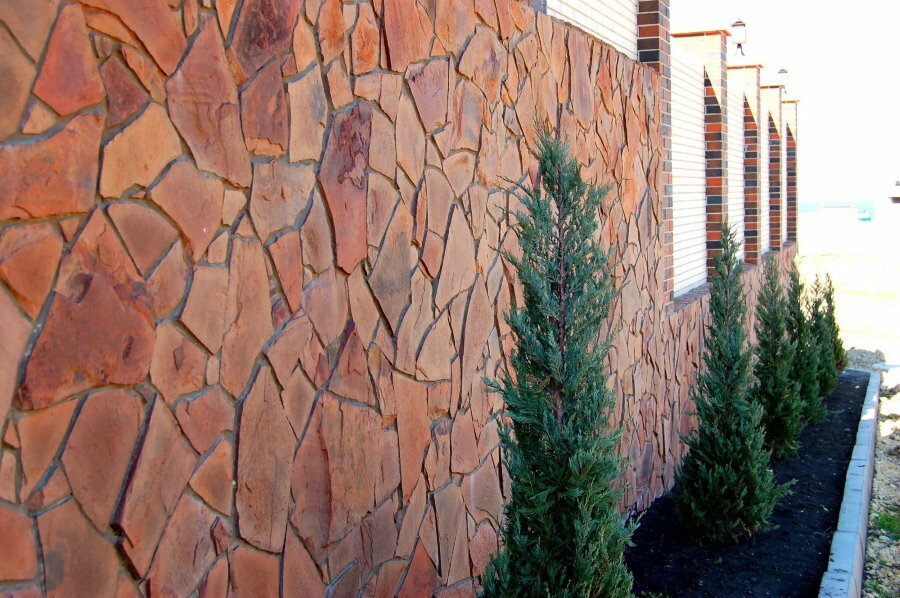
Flat sandstone is often used for cladding concrete fences
Fake diamond
The main advantages of artificial stone are the richness of the assortment, frost resistance, low weight, which does not force too massive foundations, and an affordable price. In addition, visually, especially for an uninitiated person, it is almost impossible to distinguish it from a natural one.
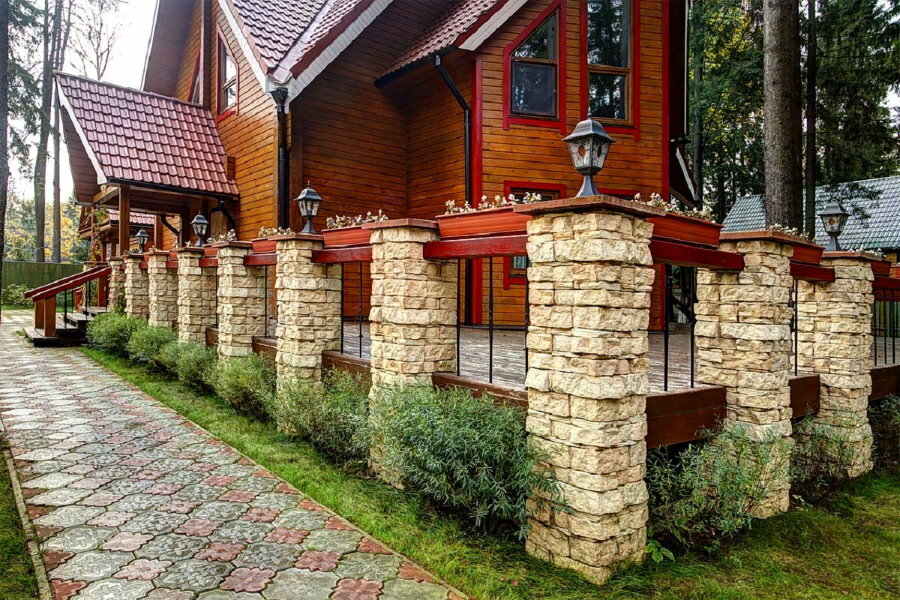
Decorative stone is much cheaper than natural stone, but it looks no worse
Stone fence decor - types of decorative finishes
You can trim a fence from cobblestone or other natural or artificial stone in a variety of ways. The most commonly used methods are:
- They make an uneven top edge, for example, form it in the form of a wavy line.
- Decorate with tiles on top, forming specific pitched planes.
- Combines forged sections installed on a stone base between stone pillars.
- The stone is laid out in such a way that it creates a certain pattern with its texture and color.
- They use the texture of the stone to create the most incredible patterns due to it. Perhaps this is the most difficult option for creating a decorative fence with a high aesthetic value.
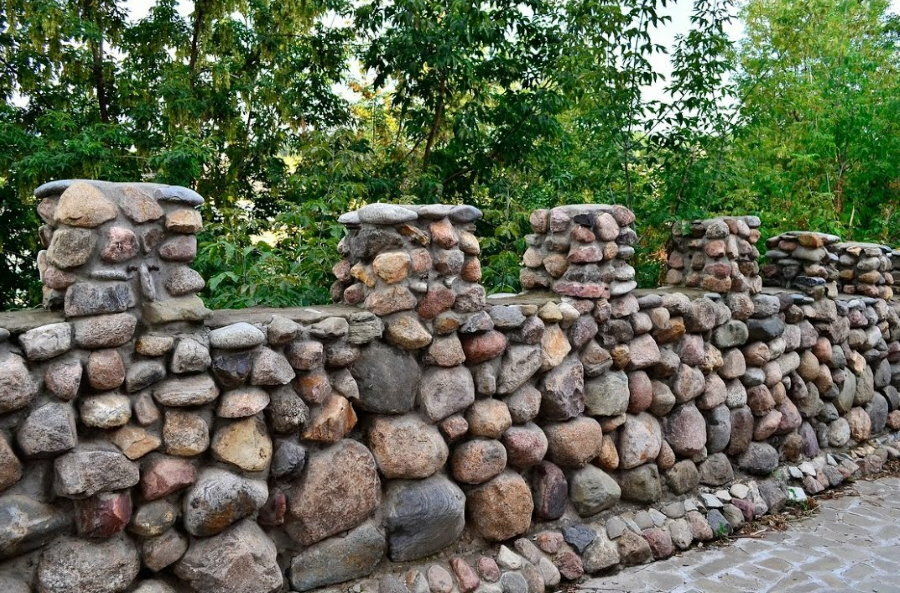
The decorative effect of a stone fence is achieved by the color, texture and shape of the stones used
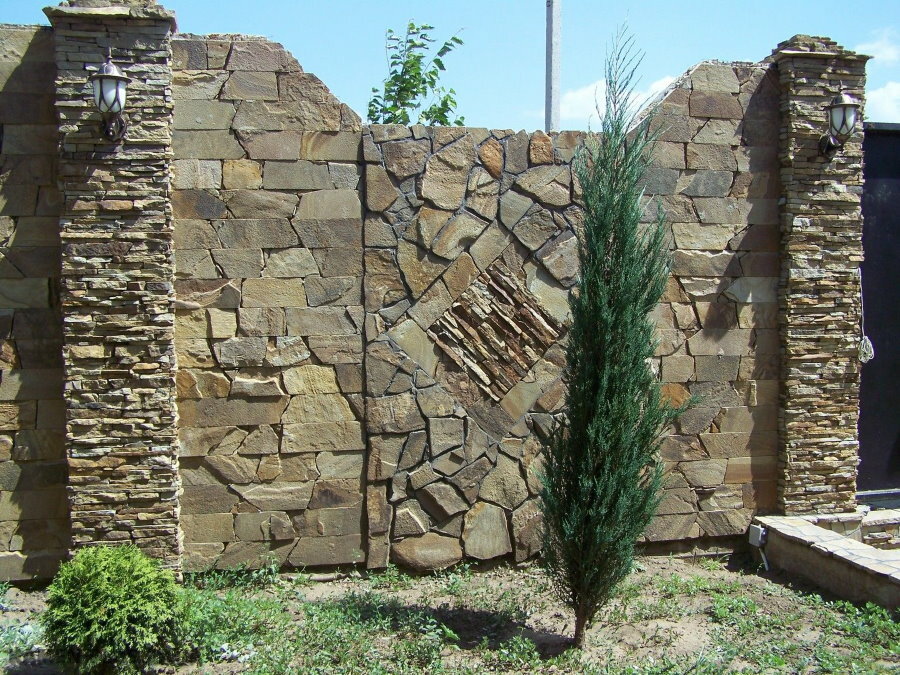
The combination of differently treated surfaces looks most impressive: smooth, torn and stabbed
Sometimes it is difficult to decide the first time which fence option is suitable for a particular site. In this case, a photo gallery of samples of such designs made in a variety of styles will help. There is plenty to choose from - a wide variety of designs are presented - from the simplest to the most complex. Therefore, you can choose a fence, both for a simple country house, and for a rich urban elite cottage.
Video: Bricklaying a fence made of rubble stone
Photos of beautiful examples of finished stone fences




